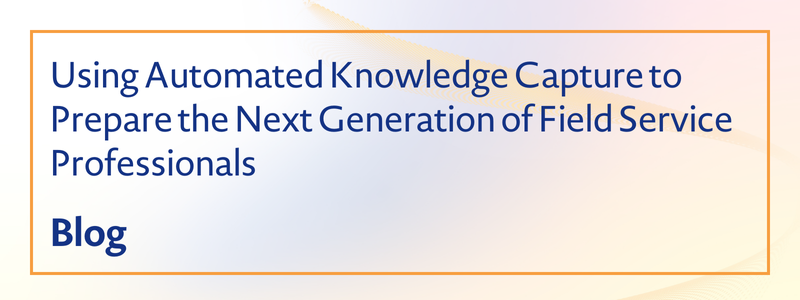Using Automated Knowledge Capture to Prepare the Next Generation of Field Service Professionals


(Source: Unsplash)
One of the most pressing challenges in the field service industry is the struggle to hire and replace departing technical talent. Experienced technicians are continuing to leave or age out of the workforce. Younger, more inexperienced technicians don't have the same wealth of knowledge as their more experienced colleagues.
When experienced technicians leave, they take their knowledge with them. The challenge for field service organizations is capturing that knowledge before it departs, so it can be transferred to new technicians.
In the past, this was often accomplished through apprenticeship and training programs. But increasingly, knowledge capture tools are enabling organizations to maintain institutional knowledge automatically.
Don't miss new reports! Sign up for The Field Service Newsletter
Automated Knowledge Capture: A Necessity in Field Service
The loss of "institutional knowledge" isn't solely an issue in field service. According to a study by E-learning software company Panopto, "On average, 42% of the skills and expertise required to capably perform in a given position will be known only by the person currently in that position. In other words, should that person leave, their remaining colleagues won't be able to do 42% of their work, and someone hired into that role will need to learn 42% of it from scratch."
Ultimately, field service organizations that can't maintain institutional knowledge must augment their workforce with experienced contract technicians to scale and meet service demands. This is often costly and unsustainable.
This challenge is compounded by the fact that products are becoming more intrinsically complex in their construction. Many machines are now outfitted with sensors or other features that enable them to connect to the IoT. Although these new designs provide the benefit of enhanced data collection, they are also creating a new realm of knowledge that needs to be absorbed by technicians in the field.
The convergence of these workforce trends suggests that a powerful knowledge management framework is now necessary within the field service organization. Such a framework must support contract technicians and new hires as they become familiar with the products they will repair in the field.
More importantly, the automation of knowledge capture is necessary to enrich the knowledge management system at large. Few field service professionals have the time to participate in surveys and studies, so that they may impart their knowledge in a meaningful way.
How Knowledge Capture Tools Can Help
Knowledge capture is the process of converting tacit knowledge—knowledge that can't be transferred to another person by writing it down or speaking it aloud—into explicit knowledge, which is knowledge that can be articulated, stored, codified, and transferred. A knowledge capture environment is a system that can capture tacit knowledge, store it, and transform it into explicit knowledge so that it can be leveraged by other people.
In general, there are two elements of knowledge capture. These are back-end knowledge capture—the capturing of high-level insights through analytical math and pattern recognition—and front-end knowledge capture—the capturing of technician best practices and other tactile elements of the field service role. Each works together to improve business outcomes and deliver a better customer experience, often through proactive, predictive, and automated maintenance.
In a recent report by WBR Insights and the Field Service conference series entitled, "Your Automated Knowledge Capture Playbook: How to Scale Your Service Organization," researchers found that 69% of field service organizations believe front-end knowledge capture is either "very important" or "extremely important." The study also found that 44% of organizations consider back-end knowledge either "very important" or "extremely important."
Automated knowledge capture tools are generally software programs combined with certain types of hardware, such as sensors, cameras, or even an everyday smartphone. They can harvest the knowledge of field service professionals by converting on-the-job experiences into knowledge assets with little to no human touch whatsoever. These assets that are created could be documents and charts, but they can also be datasets, digital processes, and even videos or interactive media.
Once captured, these knowledge assets can be disseminated throughout the organization to assist in training programs and to solidify best practices across field service staff. Developing a formal knowledge capture, management, and transfer program is key to creating better customer outcomes, even as experienced team members retire, and new professionals are brought into the organization.
Learn More at the Field Service Virtual Summit
By implementing automated knowledge capture tools, your field service organization can maintain a knowledge base to empower the next generation of field technicians and provide customers with faster, more effective service.
But knowledge capture is just one part of the many strategies field service organizations are using to prepare for the future. In the coming years, field services leaders will switch to a more preemptive, autonomous service model and develop more service processes enhanced by AI and other innovative technologies.
To learn more about what the future of field service will look like, don't miss the next event from the Field Service conference series.